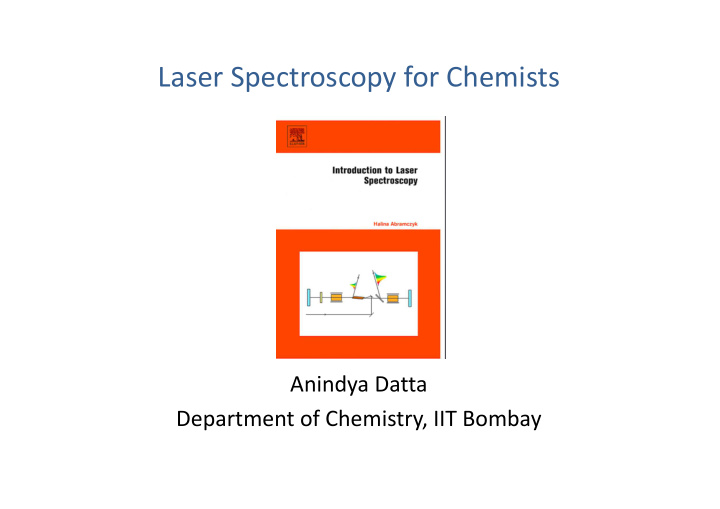



Laser Spectroscopy for Chemists Anindya Datta Department of Chemistry, IIT Bombay
Properties of laser Intensity • Monochromaticity • Pulsed operation • Coherence • 31 ‐ 07 ‐ 2019
High resolution spectroscopy Spectrum of ICl Ordinary Spectrometer Laser Spectrometer Resolution: 3 × 10 ‐ 5 cm ‐ 1 Resolution: 0.03 cm ‐ 1 Physical Chemistry, McQuarrie and Simon Pp. 613 31 ‐ 07 ‐ 2019 Laser Spectroscopy 3
Control of reaction path Molecular beams Attractive PES Repulsive PES Reactant should not vibrate No vibration, no reaction Physical Chemistry, Atkins and dePaula 10 th ed. Pp. 907 ‐ 913 31 ‐ 07 ‐ 2019 Laser Spectroscopy 4
Chemical Kinetics dx k a x n dt How fast does the reaction proceed? Rate constant, k What is mechanism? Order, n H 2 + Br 2 = 2 HBr 3 d [ H 2 ] k [ H 2 ][ Br 2 2 ] 2 ] k '[ HBr ] dt [ Br Physical Chemistry, Atkins, 10 th ed. 31 ‐ 07 ‐ 2019 Ultrafast Dynamics 5
Temperature dependence: Arrhenius k Ae E a RT Origin: van’t Hoff equation (thermodynamics) Potential Energy profile Activated Complex Molecular Reaction Dynamics Q A Q B e E 0 RT k kT Q * h k = 6 10 12 s ‐ 1 Fastest reaction: = 1/ k = 170 10 ‐ 15 s ‐ 1 Ultrafast Dynamics: Femtochemistry Physical Chemistry, Atkins, 10 th ed. 31 ‐ 07 ‐ 2019 Ultrafast Dynamics 6
The most fundamental chemical process: Bond breaking How much time does it take? 1 km s ‐ 1 Atomic motion : Bond length: 1 Å Time taken? 100 fs k = 6 10 12 s ‐ 1 Fastest reaction: = 1/ k = 170 10 ‐ 15 s ‐ 1 Ultrafast Dynamics: Femtochemistry 31 ‐ 07 ‐ 2019 Ultrafast Dynamics 7
Recommend
More recommend